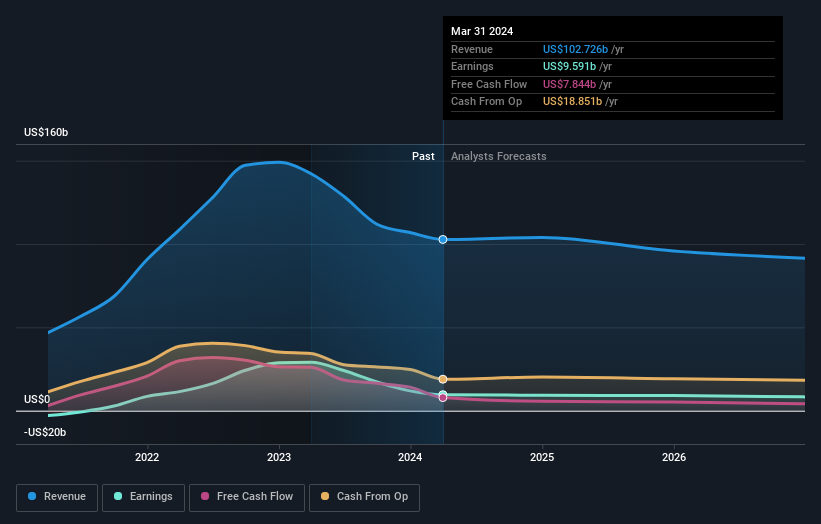- Norway
- /
- Oil and Gas
- /
- OB:EQNR
Equinor ASA Just Recorded A 26% EPS Beat: Here's What Analysts Are Forecasting Next

The quarterly results for Equinor ASA (OB:EQNR) were released last week, making it a good time to revisit its performance. It looks to have been a decent result overall - while revenue fell marginally short of analyst estimates at US$25b, statutory earnings beat expectations by a notable 26%, coming in at US$0.91 per share. The analysts typically update their forecasts at each earnings report, and we can judge from their estimates whether their view of the company has changed or if there are any new concerns to be aware of. So we collected the latest post-earnings statutory consensus estimates to see what could be in store for next year.
View our latest analysis for Equinor

Following last week's earnings report, Equinor's 18 analysts are forecasting 2024 revenues to be US$104.0b, approximately in line with the last 12 months. Statutory per share are forecast to be US$3.27, approximately in line with the last 12 months. Yet prior to the latest earnings, the analysts had been anticipated revenues of US$103.5b and earnings per share (EPS) of US$3.06 in 2024. So the consensus seems to have become somewhat more optimistic on Equinor's earnings potential following these results.
The consensus price target was unchanged at kr302, implying that the improved earnings outlook is not expected to have a long term impact on value creation for shareholders. That's not the only conclusion we can draw from this data however, as some investors also like to consider the spread in estimates when evaluating analyst price targets. There are some variant perceptions on Equinor, with the most bullish analyst valuing it at kr502 and the most bearish at kr211 per share. So we wouldn't be assigning too much credibility to analyst price targets in this case, because there are clearly some widely different views on what kind of performance this business can generate. As a result it might not be a great idea to make decisions based on the consensus price target, which is after all just an average of this wide range of estimates.
Another way we can view these estimates is in the context of the bigger picture, such as how the forecasts stack up against past performance, and whether forecasts are more or less bullish relative to other companies in the industry. We would highlight that Equinor's revenue growth is expected to slow, with the forecast 1.6% annualised growth rate until the end of 2024 being well below the historical 18% p.a. growth over the last five years. By contrast, our data suggests that other companies (with analyst coverage) in a similar industry are forecast to see their revenue shrink 5.9% per year. Factoring in the forecast slowdown in growth, it's pretty clear that Equinor is still expected to grow faster than the wider industry.
The Bottom Line
The most important thing here is that the analysts upgraded their earnings per share estimates, suggesting that there has been a clear increase in optimism towards Equinor following these results. On the plus side, they made no changes to their revenue estimates - and they expect it to perform better than the wider industry. The consensus price target held steady at kr302, with the latest estimates not enough to have an impact on their price targets.
With that in mind, we wouldn't be too quick to come to a conclusion on Equinor. Long-term earnings power is much more important than next year's profits. We have forecasts for Equinor going out to 2026, and you can see them free on our platform here.
That said, it's still necessary to consider the ever-present spectre of investment risk. We've identified 3 warning signs with Equinor (at least 1 which can't be ignored) , and understanding them should be part of your investment process.
Valuation is complex, but we're here to simplify it.
Discover if Equinor might be undervalued or overvalued with our detailed analysis, featuring fair value estimates, potential risks, dividends, insider trades, and its financial condition.
Access Free AnalysisHave feedback on this article? Concerned about the content? Get in touch with us directly. Alternatively, email editorial-team (at) simplywallst.com.
This article by Simply Wall St is general in nature. We provide commentary based on historical data and analyst forecasts only using an unbiased methodology and our articles are not intended to be financial advice. It does not constitute a recommendation to buy or sell any stock, and does not take account of your objectives, or your financial situation. We aim to bring you long-term focused analysis driven by fundamental data. Note that our analysis may not factor in the latest price-sensitive company announcements or qualitative material. Simply Wall St has no position in any stocks mentioned.
About OB:EQNR
Equinor
An energy company, engages in the exploration, production, transportation, refining, and marketing of petroleum and other forms of energy in Norway and internationally.
Excellent balance sheet established dividend payer.

